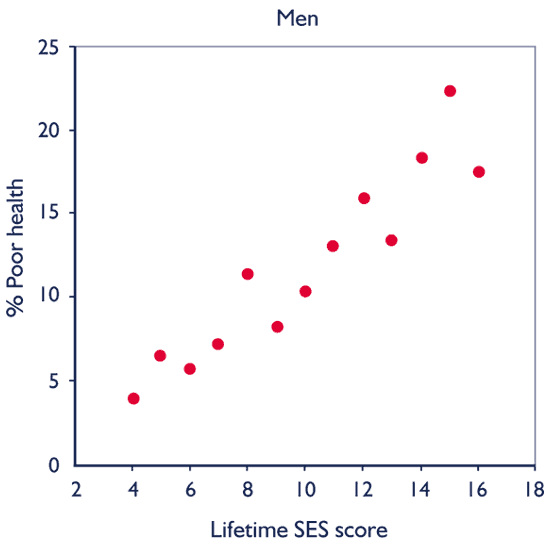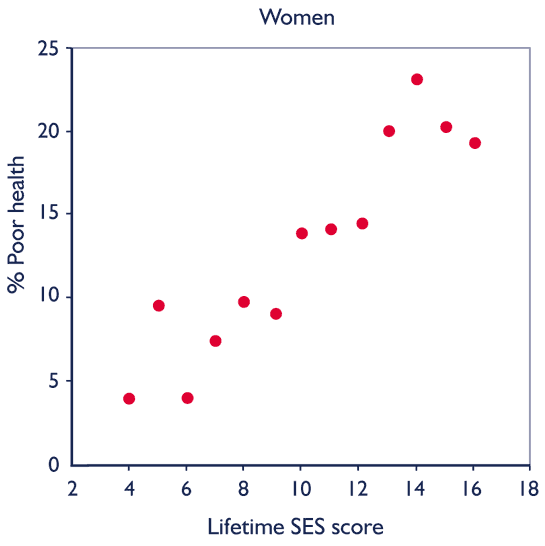 |
Close
window to return
|
Issue 5, January 2000, pp.6-7.
Duration and timing
of exposure: effects of socio-economic environment on adult health
Chris Power
Introduction
Public health policy in the UK has set its sights on the reduction of
health inequalities, inequalities which are recognised to be the outcome
of broader inequalities in life chances and living standards. Research
has established that exposure to socio-economic disadvantage both in early
life and in adult life increases the chances of poor health in adulthood.
But many questions remain. In particular, little is known about whether
the impact of socio-economic conditions on adult health varies with the
timing at which adversity occurs, or with the duration for which individuals
are exposed. We also know little about the extent to which favourable
or adverse circumstances at one life stage can modify those experienced
at another stage. Our project therefore studied the relationship between
the socio-economic environment at several life stages and adult health.
It is based on the 1958 British birth cohort, where children have been
followed up from birth to age 33.
The project addressed four questions:
- do socio-economic conditions at different life stages vary in their impact on health in early adulthood? That is, does timing matter?
- can favourable socio-economic conditions in adulthood compensate for disadvantage in early life, and conversely, can unfavourable adult conditions offset advantages gained in early life?
- does duration of exposure to favourable or adverse socio-economic conditions affect the risk of poor health in early adulthood? That is, do risks for adult health accumulate?
- do socio-economic conditions in early life influence adult health primarily through their effect on education?
We used information
on social class to indicate socio-economic conditions at four ages: at
birth and age 16 (based on father's occupation) and at ages 23 and 33
(based on the subject's own occupation). A lifetime socio-economic score
(SES) was obtained by adding the social class values (1 for highest class
to 4 for lowest class) across the four ages. This gave a lifetime SES
ranging from 4 (for those always in the highest social class) to 16 (for
those always in the lowest class).
Timing of exposure and health in adulthood
At age 33, 12% of men and women reported poor health.(1) Social class
at each age, that is at birth, and at ages 16, 23 and 33, was significantly
associated with poor adult health. Cross-classification of social class
at consecutive life stages suggested a cumulative effect, with disadvantaged
circumstances in adulthood offsetting to some extent a favourable start
in childhood, while conversely, improved adult SES was seen to compensate,
but not entirely, for disadvantage experienced in early life. This cumulative
pattern of risk was confirmed in an analysis of all four ages simultaneously:
social class at birth was associated with adult health even after allowing
for social class in early adulthood (ages 23 and 33). Conversely, class
at age 33 had an additional influence to social class at earlier ages.
The effects of social class on adult health were similar for each life
stage, suggesting that timing was not a major factor, although an exception
was seen at age 16 in men which was not significant after allowance for
social class at birth, and early adulthood.
Duration of exposure and health in adulthood
The cumulative effect on adult health is demonstrated most strikingly
with the lifetime summary measure of conditions from birth to age 33 (see
Figure 1). Only 4.1% of men with the best lifetime circumstances had poor
health at age 33, compared with 17.6% of those with the worst circumstances.
The comparable range for women was 3.9% to 19.4%. We estimated that each
unit increase in the lifetime SES measure increased the odds of poor health
by 15% in men and by 18% in women. Thus, each step up the class ladder
from classes IV&V to I&II at each age reduced the probability
of poor adult health. Chronic exposure to poor socio-economic conditions
therefore had an especially detrimental effect, suggesting that health
risks are influenced by duration of exposure to particular socio-economic
environments.
Figure 1: Poor health(1) at age 33 and cumulative socio-economic circumstances
(birth to age 33)


Copyright 1999 by the American Public Health Association.
In further analyses we showed that level of education was also strongly
associated with poor health at age 33. However, the effects of education
and lifetime SES were to a large extent independent of each other. This
implies that the lifetime SES effect does not merely reflect the well-established
association between education and health. Lifetime SES provides a cumulative
measure of socio-economic conditions which is at least as important as
education in relation to self-rated health in early adulthood.
Our study therefore suggests that duration of exposure to socio-economic
conditions has a strong predictive effect on health in early adulthood.
By using four time points, our study emphasises that, at least for self-rated
health, a finer gradation of risk emerges with increasingly refined lifetime
SES scales and that no particular life stage predominates. Furthermore,
as most previous work has been confined to male samples, with few exceptions,
less is known about lifetime SES influences on health among women. In
the 1958 cohort, similar cumulative SES effects existed for both sexes
in their early adulthood.
The persisting and cumulating effects of SES at different life stages
could operate through alternative pathways involving, for example, physical
characteristics acquired at an early age, or through educational achievement
and social skills. Some studies of adult health consider these differing
pathways. Evidence exists in the child development literature that both
physical characteristics and educational achievement are themselves influenced
by cumulative SES (or more precisely, duration of exposure measures) in
early life. Thus, long duration of low family income was found to adversely
affect an offspring's cognitive development at age 5, school achievement
at age 12, adult earnings, and childhood stunting (low height for age).
For each outcome, greater effects were evident for persistent poverty
than for transitory poverty (except for childhood stunting when transitory
poverty early in life was also important). This work highlights the importance
of considering duration of exposure to economic hardship for 'outcomes'
that in turn, either directly or indirectly, relate to adult health.
Our study could be interpreted as providing support for the "early
life origins" of adult disease hypothesis, in that there was a persisting
effect of SES at birth. However, the findings were not particularly supportive
of differential timing effects, especially among women. Even for the ten
year period during early adulthood, a separate contribution was observed
for the two ages examined: that is, SES at age 23 was associated with
later poor health after allowing for current (age 33) circumstances. This
may be signalling that the time around labour market entry may also have
long-lasting associations with later health, as has been shown previously
for mortality.
Conclusion
In the 1958 birth cohort study, social class at four life stages predicted
poor health at age 33. Duration of exposure to socio-economic conditions
therefore appears to be an important factor to consider in the prediction
of adult health. It should be noted that this analysis has focused on
poor health only. An important next stage for lifecourse studies of health
inequalities is to establish if such relationships depend on the adult
health outcome, since there may be different lifecourse associations for
different outcomes.
Nonetheless, our project has some important policy implications. Its finding
- that disadvantage in infancy, in adolescence and in early adulthood
all make a contribution to the chances of poor health in adulthood - suggests
that long-term exposure to disadvantage is especially detrimental to health
while improving socio-economic circumstances in adulthood can compensate,
at least in part, for a disadvantaged start in life. Such findings lend
support to programmes like Sure Start which aim to lift children heading
towards long-term disadvantage onto more advantaged trajectories, and
Welfare-to-Work which seeks to reverse earlier disadvantages by providing
a ladder into paid work for young people and adults on welfare benefits.
This article is based on:
Power, C., Manor, O. and Matthews, S. (1999) 'The duration and timing
of exposure: effects of socio-economic environment on adult health' American
Journal of Public Health, 89, 1059-65.
Notes
1. This includes the percentage rating their health as "fair"
or "poor".